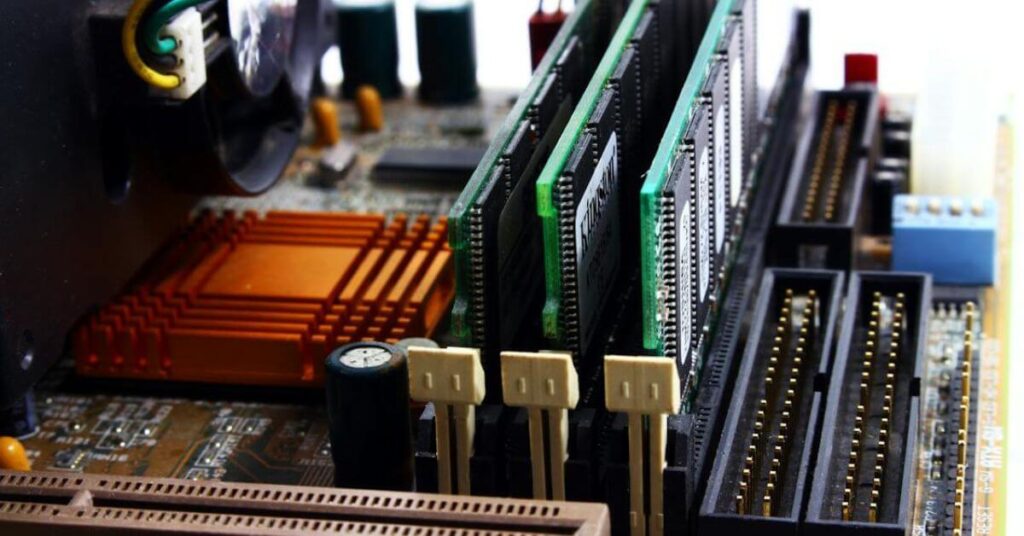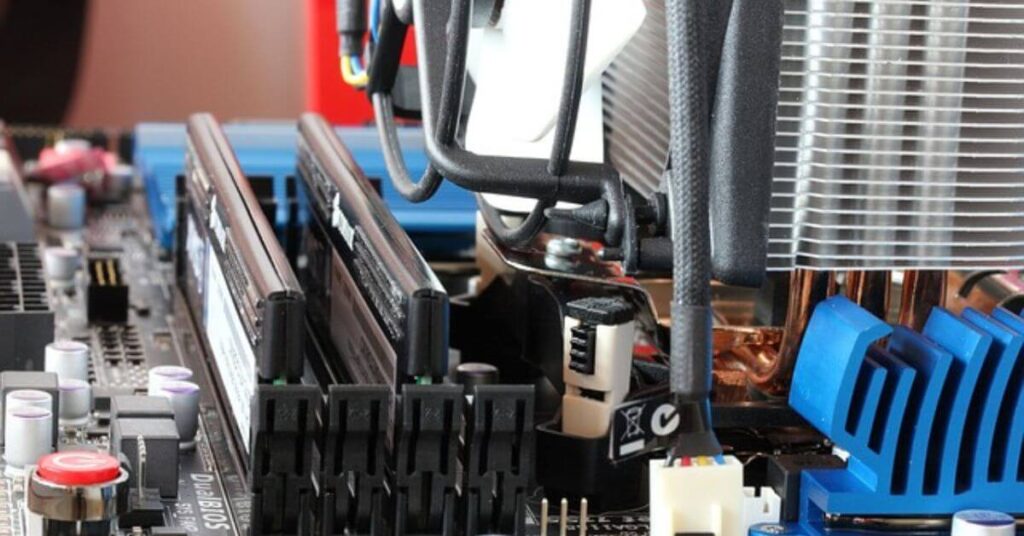Ever wondered about the best RAM slots for your computer? It’s like finding the perfect puzzle piece! Let’s keep it simple: Which RAM slots to use? We’ll guide you through this tech maze, helping your computer shine with top-notch performance. Let’s make your RAM slot choices a breeze!
Table of Contents
The Effect of RAM on System Performance Explained
Random Access Memory, or RAM, is a key component that determines how well your computer performs. RAM is a type of volatile memory that is actively used by the system during task execution, in contrast to long-term storage devices like hard drives or SSDs. It has a considerable effect on system performance for both routine and demanding operations.
1: Speed and Responsiveness
- RAM stores data that the processor needs to access quickly. The more RAM you have, the more data can be readily available for the CPU. This results in faster response times, reducing lag and enhancing overall system speed.
2: Multitasking Ability
- RAM allows your computer to handle multiple tasks simultaneously. When you run applications or open files, they are loaded into RAM for quick access. Inadequate RAM can lead to slowdowns, especially when juggling several tasks at once.
3: Gaming Performance
- Gamers often notice a direct correlation between RAM and gaming performance. Games with high-quality graphics and complex environments require substantial RAM to load textures and assets swiftly. Sufficient RAM ensures a smoother gaming experience.
4: Software and Application Performance
- RAM is critical for running software and applications efficiently. Video editing, graphic design, and other resource-intensive tasks benefit significantly from ample RAM, enabling faster rendering and smoother operation.
5: Preventing Bottlenecks
- In a well-balanced system, RAM helps prevent bottlenecks by providing the necessary data to the CPU. This ensures that the processor doesn’t have to wait for data, optimizing the overall performance of the computer.

Importance of RAM slot order
RAM slot order is crucial for optimizing memory module efficiency and improving system performance. When RAM sticks are inserted into designated slots in multi-channel architectures, dual–, triple-, or quad-channel configurations can be achieved. This optimization makes it possible for the CPU to access data more quickly, which enhances responsiveness and speed.
Comprehending the appropriate sequence guarantees that matched slots function in unison, averting possible obstructions. In the end, placing RAM modules in the proper slots strategically improves the computer’s overall performance, so doing so is crucial for users who want to utilize all of their system’s memory.
Dual-channel setups to achieve maximum performance
Dual-channel configurations play a vital role in boosting your computer’s performance. Here’s why they matter:
- Faster Data Transfer: Dual-channel setups use two separate paths for data transfer between RAM and the CPU, doubling the potential bandwidth. This results in faster data access and improved system responsiveness.
- Improved Multitasking: With dual-channel configurations, your computer can handle multiple tasks simultaneously more efficiently. This is especially beneficial for tasks like gaming or running resource-intensive applications.
- Optimized RAM Utilization: By utilizing two memory modules simultaneously, dual-channel configurations make better use of available RAM. This leads to improved memory efficiency and can positively impact overall system speed.
- Better Gaming Experience: Gamers often notice a performance boost in dual-channel setups, as games with high graphics demands benefit from the increased data transfer capabilities. This results in smoother gameplay and reduced lag.
- Simple Placement Rules: Placing RAM modules in specific pairs, usually labeled as A1 & B1 or A2 & B2, activates dual-channel mode. It’s a straightforward process that significantly enhances memory performance without complex configurations.
Further reading: How to update chipset drivers?
Explanation of slot pairs (A1 & B1, A2 & B2) and their significance
Understanding slot pairs, such as A1 & B1 or A2 & B2, is crucial for optimizing your computer’s memory performance. Here’s why these pairs matter:
- Dual-Channel Activation
- Slot pairs like A1 & B1 or A2 & B2 are crucial for activating dual-channel memory mode on your motherboard.
- Separate Channels
- Each pair represents a separate memory channel. Dual-channel configurations use two channels simultaneously, enhancing data transfer speed.
- Optimized Bandwidth
- Placing modules in these pairs optimizes memory bandwidth, allowing for faster communication between RAM and the CPU.
- Balanced Access
- A1 & B1, or A2 & B2 configurations ensure balanced access to memory channels, preventing bottlenecks and improving overall system performance.
- Simple Installation Rules
- Following motherboard guidelines on slot pairs is straightforward. It simplifies the process of setting up dual-channel configurations for users without intricate technical knowledge.
Slot pairs like A1 & B1 or A2 & B2 are integral for activating dual-channel memory, optimizing data transfer, and ensuring a balanced and efficient use of your computer’s memory resources.

Guidelines for different RAM scenarios
Proper placement of RAM modules is essential for optimal system performance. Here are guidelines for various RAM scenarios, emphasizing the importance of consulting the motherboard manual:
1: Single RAM Stick
- Place the single RAM stick in the designated slot, usually labeled A2. Refer to the motherboard manual for the specific placement recommendation.
2: Two RAM Sticks:
- For dual-channel memory, use slot pairs such as A2 & B2 or 2 & 4. These slots are typically furthest from the CPU socket and one position away from each other. Follow the motherboard manual for precise instructions.
3: Three RAM Sticks:
- Position the third stick between the A2 & B2 slots for optimal distribution. Again, consult the motherboard manual for the recommended arrangement.
5: Four RAM Sticks (Four-Slot Motherboard):
- Utilize every available slot for each stick. Ensure correct placement in accordance with the motherboard manual to activate dual-channel or other designated configurations.
6: Motherboards with More Than Four RAM Slots:
- Consult the motherboard manual for specific slot configurations.
- If your motherboard supports triple or quad-channel memory, follow the recommended patterns for optimal performance.
7: Special Configurations (e.g., Five, Six, Seven, Eight RAM Sticks):
- Follow the guidelines outlined in the motherboard manual for these unique scenarios.
- Maintain symmetry where applicable and ensure proper distribution for balanced performance.
Importance of Consulting the Motherboard Manual
- Motherboards may have unique layouts and configurations.
- The manual provides precise instructions for RAM placement based on the motherboard’s design.
- Incorrect placement may lead to compatibility issues, reduced performance, or system instability.
- Following the manual ensures that RAM modules work together seamlessly, optimizing the memory subsystem.
Installing RAM on a Desktop
- Shutdown and Disconnect: Turn off your computer and disconnect all cables. This ensures safety during the installation process.
- Access the RAM Slots: Open the computer case to access the RAM slots on the motherboard. Refer to your computer manual for guidance.
- Release Existing RAM Modules (if applicable): If replacing existing RAM, release the clips holding them in place. Gently pull out the old modules.
- Line Up New RAM Sticks: Align the notches on the RAM stick with those on the slot. Be cautious and touch only the corners to avoid damaging components.
- Insert RAM into Slots: Firmly press down on both ends of the RAM stick until the clips lock it in place. Ensure it’s securely seated.
- Close Computer Case: Close the computer case, reconnect all cables, and turn on your PC. Allow your motherboard some time to recognize the new memory.
- Restart Your Computer: After installation, restart your computer. It may take a few minutes for the system to adjust to the new memory.
Installing RAM on a Laptop
- Shutdown and Disconnect: Turn off your laptop and unplug all cables to ensure safety during the installation.
- Locate RAM Access Panel: Some laptops have a dedicated access panel for RAM. Refer to your laptop’s manual to find it.
- Remove Existing RAM Modules (if applicable): If upgrading, release the clips holding the existing RAM in place and gently remove them.
- Align New RAM Sticks: Align the notches on the new RAM stick with those on the slot. Handle the RAM stick carefully.
- Insert RAM into Slot: Carefully push down on both ends of the RAM stick until it locks into place. Ensure a secure fit.
- Replace Access Panel: Close the access panel, secure it in place, and reconnect all cables.
- Turn On Your Laptop: Power on your laptop and allow it to recognize the new memory. Restart the laptop for the changes to take effect.
Special Considerations for Mac Systems
- Mac Systems RAM Upgrade: Mac and MacBook RAM modules are often soldered onto the motherboard, limiting user upgrades. Check your Mac’s specifications to determine if a RAM upgrade is possible.
- Check Apple’s Configurations: Apple offers various RAM configurations for its products. When purchasing a Mac, choose the RAM capacity that suits your needs, as upgrading may not be feasible.
- Professional Upgrade Assistance: If your Mac supports user-upgradable RAM, consider seeking professional assistance or referring to Apple’s official guidelines to ensure a smooth and compatible upgrade process.
- Compatibility and Capacity: Verify the RAM specifications compatible with your specific Mac model. Apple’s website or support documentation can provide details on the supported RAM type and capacity.
Final words
Selecting the correct RAM slots is crucial; accuracy is required to maximize the performance of your computer. It’s important to understand slot pairings such as A1 & B1 or A2 & B2, whether you’re using one or more RAM sticks. When properly positioned slots are used to activate dual-channel configurations, performance is greatly increased, particularly for tasks requiring quick access to data.
A smoother computing experience is achieved by ensuring an efficient distribution of memory through guidelines tailored to different scenarios. Always keep in mind that the motherboard manual is your guide through the complex world of RAM slot configurations, which in the end determines the stability, speed, and responsiveness of your system.
Which RAM slots to use? FAQ
How do I activate dual-channel memory?
To activate dual-channel memory, use specific slot pairs like A1 & B1 or A2 & B2. Placing RAM modules in these pairs allows for simultaneous data transfer, boosting overall performance.
What if my motherboard has more than four RAM slots?
Consult the motherboard manual for specific slot configurations. For motherboards with more than four slots, follow the recommended patterns for optimal performance, especially if supporting triple or quad-channel memory.
Can I mix different RAM sizes or speeds in dual-channel configurations?
While it’s possible, it’s advisable to use identical RAM modules for dual-channel configurations to ensure optimal performance. Mixing sizes or speeds may result in suboptimal performance.
